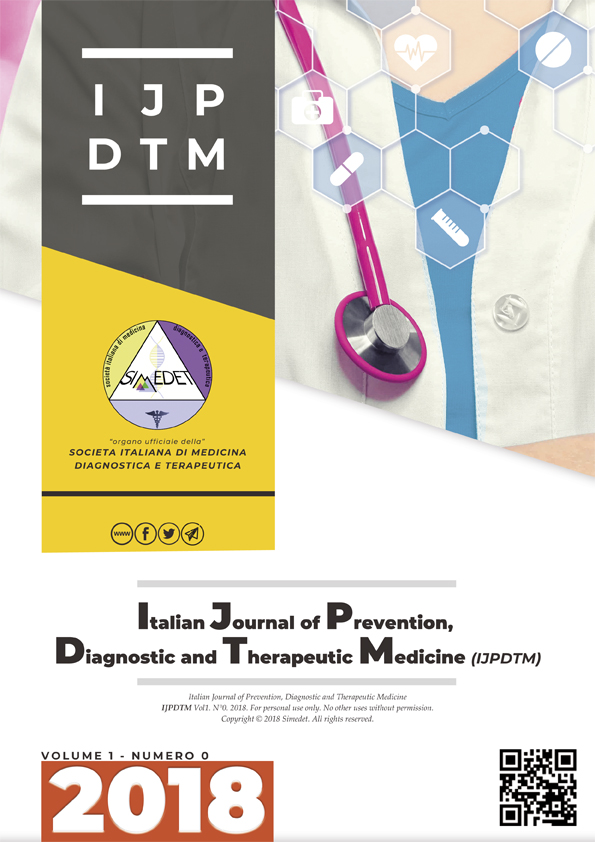The health literacy of the foreign user as a tool to prevent overcrowding of emergency and emergency services: exploratory investigation at the U.O. Emergency Department of Mestre
Main Article Content
Abstract
BACKGROUND
The problem of overcrowding in the Emergency Room is extremely current and discussed, because there is often a bad use of this service, that has to be used only in case of emergency and urgency, with clinical problems that can’t be in any way subjected to other structures of national health system.
The lack of health literacy, which means the necessary competence and abilities to use the health services, can be recognized as one of possible causes of overcrowding in ER.
It is inevitably necessary to have healthcare professionals culturally competent, that really know how to personalize its work by focusing the attention on cultural diversity.
At the same time it is really important to form citizens that are able to communicate in an efficient way with health system and that can find and assess the information.
OBJECTIVES
This study aims to contextualize the phenomenon of overcrowding in ER and it also will define if there is a lack of health literacy in foreign patients that access to ER with non - urgent codes.
METHOD
Study design: a scoping study in the Emergency Room of Ospedale dell’Angelo di Mestre, during the months of July and August 2017.
Sampling: includes foreign patients with an age range of 16 to 70 years that had access to ER with non – urgent codes.
Method and technique of data collection: administration of an anonymous survey on the basis of voluntariness of participants.
Data analysis: the answers have been statistically analyzed in order to obtain the result as a percentage.
RESULTS
The distribution of the answers is uniform and does not vary to the change of interviewed users.
The results confirm that there is a widespread lack of health literacy.
DISCUSSION
Health Literacy of users has to be carefully evaluated and, if it is inadequate, implemented through the closest relationship between Nurse and patient.
The training of health professionals has to be based on an efficient communication and it is necessary to evaluate the ability in the use of those specific tools that are useful to recognize lack of health literacy.
CONCLUSIONS
The analysis of the data agrees with all that literature confirms, or rather that is becoming increasingly necessary to have cultural competence and to have healthcare professional up to date with society.
The implementation of health literacy could reduce the accesses in ER and all the negative consequences linked to them.
Downloads
Article Details

This work is licensed under a Creative Commons Attribution-NonCommercial-NoDerivatives 4.0 International License.
References
Simeu: Ogni anno 24 milioni di accessi, quasi uno al secondo. Ma mancano letti in corsia e l'influenza c'entra poco, 2015. Disponibile da www.quotidianosanita.it/lavoro-e-professioni/articolo.php?articolo_id=25375. [ultima consultazione 10.08.2018];
ISTAT. Salute e Sanità, (2011-2012). Disponibile da https://www.istat.it/it/archivio/110879. [ultima consultazione 10.08.2018];
World Health Organization. Health Literacy and Health Behaviour, 2013. Disponibile da www.who.int/healthpromotion/conferences/7gchp/track2/en/. [ultima consultazione 10.08.2018];
Mackenbach P., Health inequalities: Europe in profile, An independent, expert report commissioned by the UK Presidency of the EU, 2006. Disponibile da www.who.int/social_determinants/.../european_inequalities.pdf. [ultima consultazione 10.08.2018];
Purnell L., Davidhizar R. E et al. A guide to developing a culturally competent organization, J Transcult Nurs, 2011, 22 (1): 1 – 7;
Wood M. Cultural safety and the socioethical nurse. Nurs Ethics, 2010, 17 (6): 715 – 725;
Papadopoulos I. The Papadopoulos, Tilki and Taylor model of developing cultural competence. Transcultural health and social care. Development of culturally competent practitioners, 7 – 24. Pechino: Elsevier Limited: 2006;
Takeno Y. Facilitating the transition of Asian nurses to work in Australia. J Nurs Manage, 2010, 18 (2): 215 – 224;
Cartabellotta N., et al. (2016). Rapporto sulla sostenibilità del Servizio Sanitario Nazionale 2016-2025. Fondazione GIMBE, 7 giugno 2016, Roma;
Macabasco-O'Connell, A., & Fry-Bowers, E.K. Knowledge and perceptions of Health Literacy among nursing professionals. J Health Commun, 2011, 16 (3): 295 – 307;
Sørensen K., et al., Health literacy and public health. A systematic review and integration of definitions and models. BMC Public Health, 2012, 12(1): 12 – 80;
Teach back and Health Literacy. University of Washington School of Nursing, 2012;
Il Codice deontologico dell'Infermiere, 2009;
The Public Health Nurse's role in achieving health equity: eliminating inequalities in health, 2015. Disponibile in:
http://phnurse.org/resources/APHN%20Health%20Equity%20Paper-%20Version%20%2012-3-15%20(2).pdf [ultima consultazione 10.08.2018];
Nursing Beyond Borders: access to health care for documented and undocumented immigrants living in the US, 2010. Disponibile in https://www.nursingworld.org/~4af0ba/globalassets/docs/ana/ethics/nursing-without-borders_-access-to-care-for-immigrants.pdf. [ultima consultazione 10.08.2018].

